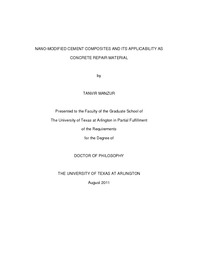
ATTENTION: The works hosted here are being migrated to a new repository that will consolidate resources, improve discoverability, and better show UTA's research impact on the global community. We will update authors as the migration progresses. Please see MavMatrix for more information.
Show simple item record
| dc.contributor.author | Manzur, Tanvir | en_US |
| dc.date.accessioned | 2011-10-11T20:48:52Z | |
| dc.date.available | 2011-10-11T20:48:52Z | |
| dc.date.issued | 2011-10-11 | |
| dc.date.submitted | January 2011 | en_US |
| dc.identifier.other | DISS-11283 | en_US |
| dc.identifier.uri | http://hdl.handle.net/10106/6180 | |
| dc.description.abstract | Nanotechnology or Nano-science, considered the forth industrial revolution, has received considerable attention in the past decade. The physical properties of a nano-scaled material are entirely different than that of bulk materials. With the emerging nanotechnology, one can build material block atom by atom. Therefore, through nanotechnology it is possible to enhance and control the physical properties of materials to a great extent. Composites such as concrete materials have very high strength and Young's modulus but relatively low toughness and ductility due to their covalent bonding between atoms and lacking of slip systems in the crystal structures. However, the strength and life of concrete structures are determined by the microstructure and mass transfer at nano scale. Cementitious composites are amenable to manipulation through nanotechnology due to the physical behavior and size of hydration products. Carbon nanotubes (CNT) are nearly ideal reinforcing agent due to extremely high aspect ratios and ultra high strengths. So there is a great potential to utilize CNT in producing new cement based composite materials.It is evident from the review of past literature that mechanical properties of nanotubes reinforced cementitious composites have been highly variable. Some researches yielded improvement in performance of CNT-cement composites as compared to plain cement samples, while other resulted in inconsequential changes in mechanical properties. Even in some cases considerable less strengths and modulus were obtained. Another major difficulty of producing CNT reinforced cementitious composites is the attainment of homogeneous dispersion of nanotubes into cement but no standard procedures to mix CNT within the cement is available. CNT attract more water to adhere to their surface due to their high aspect ratio which eventually results in less workability of the cement mix. Therefore, it is extremely important to develop a suitable mixing technique and an optimum mix proportion to produce CNT reinforced cement composites. In this study, an extensive parametric study has been conducted using different types of treated and untreated multi walled nanotubes (MWNT) as reinforcement of cementitious composites having different mix proportions. It is found that mixing of nanotubes within cement matrix is the key to develop composites having desirable properties. A mixing technique has been proposed to address the issues related to dispersion of nanotubes within cement matrix. Polycarboxylate based super plasticizer has been proposed to use as surfactant. It is evident that there exists an optimum concentration of MWNT and mix proportion to achieve proper reinforcement behavior and strength properties. The affect of size of MWNT on strengths (both compressive and flexure) of composites has also been investigated. Based on the parametric study and statistical analysis, a tentative optimum mix proportion has been proposed. Composites made by the proposed mixing technique and design mix obtained 26, 27 and 16% higher compressive strength as compared to control samples at the age of 3, 7 and 28 day, respectively. Flexural strengths of those composites at 3, 7 and 28 day were about 24, 24.5 and 20% higher than that of control samples, respectively. It has also been suggested that application of MWNT reinforced cement mortar as concrete repair material has excellent potential since composites exhibited desirable behavior in setting time, bleeding and slant shear. | en_US |
| dc.description.sponsorship | Yazdani, Nur | en_US |
| dc.language.iso | en | en_US |
| dc.publisher | Civil & Environmental Engineering | en_US |
| dc.title | Nano-modified Cement Composites And Its Applicability As Concrete Repair Material | en_US |
| dc.type | Ph.D. | en_US |
| dc.contributor.committeeChair | Yazdani, Nur | en_US |
| dc.degree.department | Civil & Environmental Engineering | en_US |
| dc.degree.discipline | Civil & Environmental Engineering | en_US |
| dc.degree.grantor | University of Texas at Arlington | en_US |
| dc.degree.level | doctoral | en_US |
| dc.degree.name | Ph.D. | en_US |
Files in this item
- Name:
- Manzur_uta_2502D_11283.pdf
- Size:
- 13.44Mb
- Format:
- PDF
This item appears in the following Collection(s)
Show simple item record


